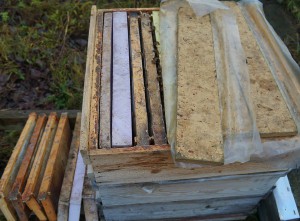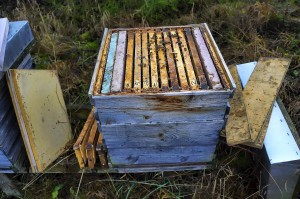I live on 59 degrees north and 15 degrees east in Sweden. It can be quite cold in winter and bees can’t usually leave the hive a single time from about November until about middle of March, sometimes late in April.
I use single walled wooden boxes for the hives (no insulation) with no wrapping for winter, so the colonies need to be strong to winter well and be able to get a crop from the winter rape in May. No top ventilation. But bottom ventilation, through the entrance and through netting in the back corners of the bottom board.
I use square shallow boxes for 12-13 frames (depending on center to center distance) (frames 448×137 mm) throughout the hive, no other frame size. It works surprisingly well one may think. One square shallow box has the same volume as one medium, 10 frame (Illinois–3/4-Langstroth, 448×159 mm frames). Two square shallows correspond to a 12-frame modified dadant or jumbo box (448×286 mm frames). I normally use three square shallow boxes for winter (and as brood nest in summer with excluder) with the top third box full of or with a lot of honey, complementing with sucrose solution in August/September adding up to about 30 kg of food (65 pounds[lb]).
Smaller colonies get dummy insulation as outer frames, after combs filled with food are removed in late autumn. They may get the entrance somewhat reduced. These colonies are mostly wintered on two square shallows (with somewhat less honey and total food). The smaller colonies the more insulation they get to winter well.
After feeding sugar in September, temperature is low enough in October or November to keep the bees inside all day and clustered together tightly. Now the old bees have died off and left the winter bees for taking the colony through winter. The cluster is reduced as a result of this and also as a result of temperature compressing the bees together to keep them from loosing heat. Egglaying has normally stopped a couple of months earlier with my bees.
This situation didn’t occur this year due to relatively mild weather, as last year, until late November, with then steady temperature just above freezing. I then checked all colonies concerning strength and removed some outer frames replacing them with insulation dummy frames of compact polystyrene. Some smaller colonies had already been reduced this way in August in both upper and lower boxes. At this point only the upper box get outer frames removed. I have a plastic sheet covering the top and lift up and folded somewhat at one side at a time to help the colony keep warmth when working. The bees are usually calm and don’t move much if I work fast.
In August all three boxes are full of bees on all combs. When sitting in winter cluster in November in average this year they are sitting tight filling up about 7 frame gaps in about two boxes, in the middle box and somewhat in the lower and upper ones. Or lower down or higher up. A colony with 8 filled gaps will not get any comb removed. 7 gaps 1-2 removed, 6 gaps 2-3 removed, 5 gaps 3-5 removed.
The smallest cluster now have 4 gaps with tightly clustered bees (with three insulation frames on each side of six combs in the upper box) and the strongest are filling 10 gaps. Watch out in early spring! Such colonies will hopefully need a super very early in spring!
Light colored bees don’t normally behave like this, they brood longer in autumn, wait longer clustering tightly, and start earlier brooding considerably in late winter.
My bees don’t use all this food for winter, they use maybe 5-8 kg (11-18 pounds). But with a good amount of honey they start heavily brooding in early March before even having made the cleansing flight after winter. Then they need the food! If they don’t have enough food you have to feed them. If feeding them sugar solution, which is common, the bees might react in easier develop swarming preparation.
The removed food combs are stored mouse tight and used for those colonies developing fast in spring and need more food. Some colonies have used too much food during winter and spring. They are not stronger than those that wait until March brooding, they might actually develop backwards due to nosema problems. Such colonies are requeened later. In second half of May I start making splits and nucs. These stored food combs are a gift.
With a good amount of food in late winter/early spring the bees “dare” to make a lot of brood. When May comes they already are filling (almost) a couple of supers above the excluder with bees and are ready to fill them with honey!

